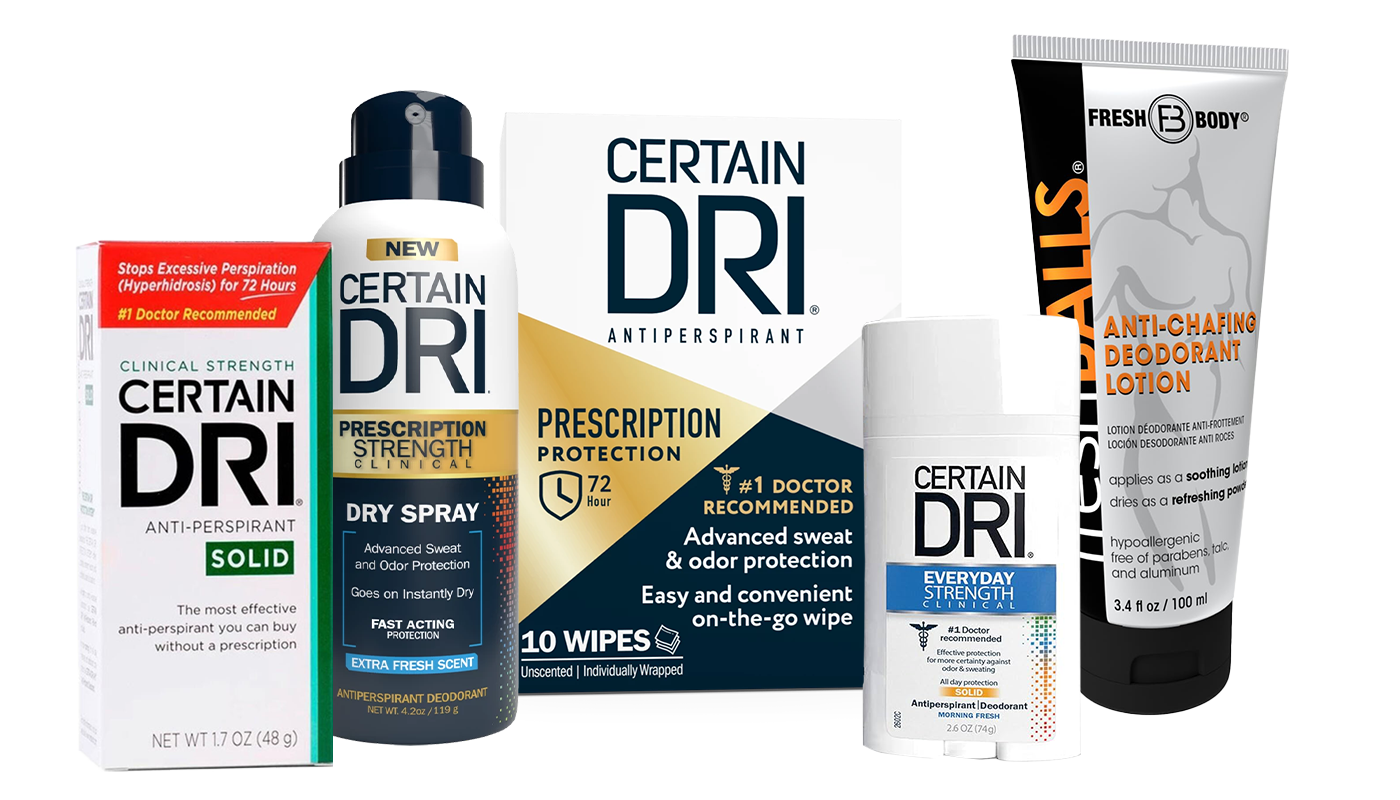Excessive Sweating – Do You Have Hyperhidrosis?
- Hyperhidrosis is a medical condition causing excessive and unpredictable sweating beyond what's needed for body temperature regulation.
- There are two main types: primary (localized sweating with unknown cause) and secondary (widespread sweating often linked to other factors).
- Management often involves over-the-counter antiperspirants containing aluminum salts, which temporarily block sweat glands.
- Certain Dri offers various OTC antiperspirant formulations with different aluminum compounds and strengths for targeted sweat control.
Do you find yourself sweating excessively, even when it's cool or you're relaxing? This could be a sign of hyperhidrosis, a medical condition that causes excessive sweating beyond what the body needs to stay cool. This sweating can happen during rest or in cool environments.
Normally, sweating is your body's way of staying cool. Sweat glands release moisture through ducts to the skin's surface. As this sweat evaporates, it helps regulate your temperature.
However, in hyperhidrosis, these sweat glands become overactive, producing far more sweat than necessary for temperature control. This can affect specific areas like the hands, feet, underarms, or face, or it can occur all over the body.
Types and Causes
Primary Hyperhidrosis
- Excessive sweating in specific areas like the hands, underarms, feet, or face.
- Cause: No clear cause and often begins in childhood or adolescence. It may run in families and is thought to be linked to overactive nerves that trigger sweat glands.
Secondary Hyperhidrosis
- Widespread sweating across larger areas of the body.
- Cause: Triggered by an underlying medical condition or as a side effect of certain medications. Unlike primary hyperhidrosis, it can occur during sleep.
Risk Factors
While the exact cause of primary hyperhidrosis is often unknown, several factors can increase the likelihood of developing excessive sweating:
- Medications and Supplements: Some drugs can cause sweating as a side effect.
- Antidepressants
- Steroids
- Pain relievers
- Certain diabetes medications
- Genetics: Hyperhidrosis tends to run in families.
- Medical Conditions
- Hyperthyroidism
- Menopause
- Specific infections
Treatment
Managing hyperhidrosis often starts at home with over-the-counter (OTC) antiperspirants. The best treatment approach depends on the affected body area, the severity of sweating, and what works best for you.
How OTC Antiperspirants Work
Most antiperspirants contain aluminum salts as their active ingredient. When applied to the skin, the perspiration mixes with these salts, forming temporary plugs in the sweat glands just beneath the skin's surface. These plugs physically block sweat and signal the body to reduce or stop sweat production in that area. Typically, these effects last for at least 24 hours before gradually washing away.

Certain Dri: A Clinical-Strength Antiperspirant
Certain Dri is a leading OTC brand recommended by doctors for people with excessive sweating. It offers several formulations designed to meet different needs:
- Prescription Strength Roll-On
- Contains 15% aluminum chloride
- For severe sweating
- Penetrates deeply into sweat ducts for long-lasting protection
- Extra Strength Solid
- Contains 25% aluminum sesquichlorohydrate
- Strong protection with a gentler formula for sensitive skin
- Everyday Strength Solid
- Contains 20% zirconium complex
- Daily use with moderate sweat control
- Prescription Strength Dry Spray
- Contains 25% aluminum chlorohydrate
- Quick-drying, invisible protection that’s gentler on skin
- Prescription Strength Wipes
- Contain 15% aluminum chlorohydrate
- On-the-go use; easy to apply and portable
- Triple Action Body Powder
- Contains Kaolin and Sodium Bicarbonate
- Absorbs sweat and reduces odor without aluminum
- Sweat Absorbing Foot Powder
- Contain Benzethonium Chloride (fights odor-causing bacteria) and Corn Starch (absorbs moisture)
Choosing Products Based on Sweating Location
Since primary hyperhidrosis usually affects specific areas of the body, it can often be managed with targeted treatments. Here’s a guide to which products work best for different body parts:
Underarms
All product types can be used here, including roll-ons, sprays, solids, wipes, and powders.
Feet
- Prescription Strength Wipes
- Prescription Strength Dry Spray
- Sweat Absorbing Foot Powder
Hands
- Prescription Strength Wipes
- Prescription Strength Dry Spray
- Triple Action Body Powder
Face
Prescription Strength Wipes
Important: Avoid applying near the eyes, nose, or mouth. If swallowed, seek medical help or contact poison control immediately, as aluminum chlorohydrate can be harmful if ingested.
Face
Triple Action Body Powder: Ideal for broader coverage without aluminum-based ingredients.
Aluminum in Antiperspirants: What You Should Know
There has been public concern about the safety of aluminum compounds in antiperspirants, particularly regarding a possible link to breast cancer. These concerns stem from early studies and media speculation.
However, extensive research has found no reliable evidence that aluminum in antiperspirants increases cancer risk. Here's what the science says:
- Aluminum in antiperspirants works by forming a temporary plug in sweat ducts to reduce sweating.
- The amount of aluminum absorbed through the skin is extremely low, much less than what we absorb from food.
- A 2014 scientific review and multiple health organizations, including the National Cancer Institute and American Cancer Society, have concluded that there is no proven link between aluminum-containing antiperspirants and breast cancer.
Ultimately, the choice to use aluminum-based products is personal. But for people with hyperhidrosis, these products remain the most effective option for managing excessive sweating.
References:
- Antiperspirant Basics. (n.d.). International Hyperhidrosis Society. Retrieved April 19, 2025, from https://www.sweathelp.org
- Brackenrich J, Fagg C. Hyperhidrosis. [Updated 2022 Oct 3]. In: StatPearls [Internet]. Treasure Island (FL): StatPearls Publishing; 2025 Jan-. Available from: https://www.ncbi.nlm.nih.gov/books/NBK459227/
- Aluminum Chloride Hexahydrate. (2022, March 24). Memorial Sloan Kettering Cancer Center. Retrieved April 19, 2025, from https://www.mskcc.org
- Hyperhidrosis. (2023, June 7). MedlinePlus Medical Encyclopedia. Retrieved April 19, 2025, from https://medlineplus.gov
- Hyperhidrosis. (2023, January 7). Cleveland Clinic. Retrieved April 19, 2025, from https://my.clevelandclinic.org
- What is Hyperhidrosis. (2022, February 19). Certain Dri. Retrieved April 19, 2025, from https://certaindri.com